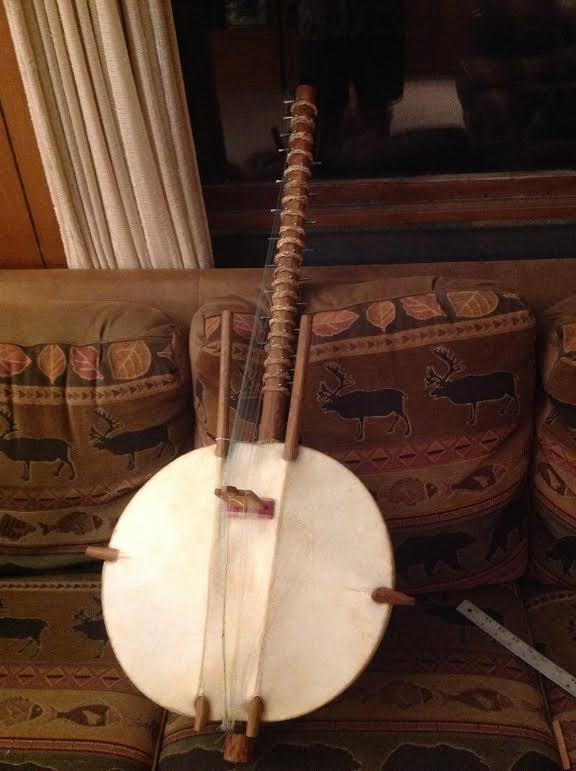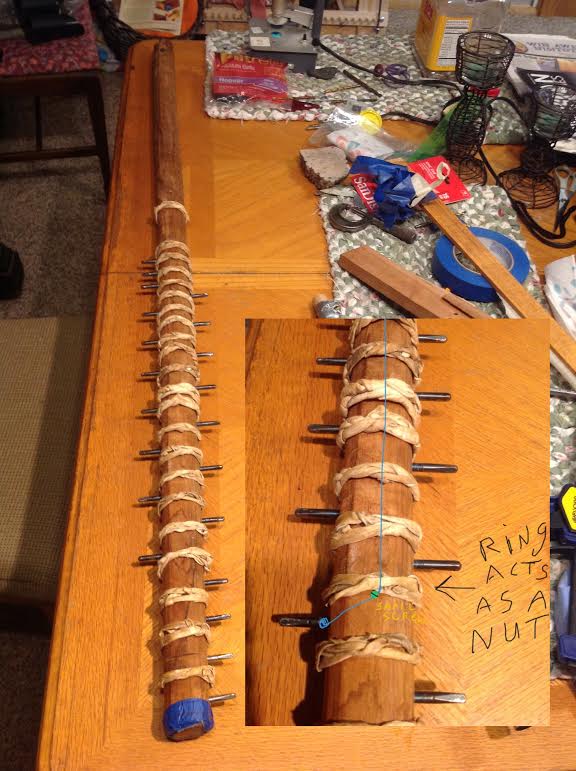
This describes a second method of replacing the traditional leather-ring (konso) tuners used on West African koras. My first method, replacing the konsos with guitar-type tuners works great (see http://www.dennishavlena.com/konso.htm ) but is not the easiest to do. The second method described here is very easy to accomplish. It uses inexpensive "zither pins" but still makes use of the existing konso rings, which are left on the neck and re-purposed as "nuts". This retains much of the traditional kora's appearance. In addition to "looking traditional", they now perform the vital function as"nuts" over which the strings start their journey to the bridge. The strings go from leather (the konso "nuts") to the wooden bridge, likely answering the objection that the steel-to-bridge of guitar type tuner conversions etc don't have the "true" kora sound. No string here touches any metal. The use of these light-weight zither pins makes for a noticeably lighter instrument than if using guitar tuners. While I really like the traditional konso system, konso tuning can be a real pain in the butt, often to the point of discouraging potential kora players. This simple conversion is fully reversible should you want to revert to the traditional leather-ring konso tuners. What I did was to mount zither pins horizontally, into the side of the neck, an inch or so behind each leather ring. After leaving the zither pin, the string passes under the head of a small screw mounted just behind the ring. The purpose of this screw is to guide and also hold down the strings so they ride nicely over the leather ring "nut". The screw also positions the strings so they runs down the neck properly (one row for the 11 left-side strings & a parallel row for the 10 right-side strings).
Click here to access
my webpage

Because the nut-to-bridge angle of the strings increase as you get nearer to the bridge,
the placement, and adjustment of the small hold-down screws for the higher pitched strings
becomes more important. For the shorter strings, try to mount them so their heads are
almost touching the leather ring. Because of this higher angle of the higher-pitched
strings, make sure that the string departs solidly from the leather ring and not from the
screw. If trouble, rotate the ring so it's thickest part is where the string rides over.
Zither pins need to be mounted in extremely hard hardwood to operate properly.
The dense African bubinga wood, used for most kora necks, meets this requirement easily.
I do not include exact dimensions here given the wide variety of neck diameters, lengths etc
kora to kora. Just referring to the photos should be sufficient. Not much is critical at all.
Luthiery books generally tell you to use a #13 "number drill bit" to drill the guide hole
that the zither-pins fit into. After installing hundreds of zither pins in a wide variety
of home-made instruments over the past 50 years, I highly recommend using a drill bit one
number smaller - #14 instead of #13. The #14 drill bit makes for a slightly snugger
zither-pin fit but still turns nicely. I have been using zither pins on koras for well
over a decade and never have had any slippage, Even with the fat bass strings). A word
about number drills: They're used by machinists because they are available in many more
diameters than "normal" drill bits. The problem is availability. A machinist should be able
to loan you this #14 drill bit or it can be ordered online. Do not attempt to use a regular
hardware-store type drill bit because there is no close match to what is required and it
will most certainly make the zither pin way too loose or too tight.
Once properly positioned for their use as nuts, the leather rings are lightly white-glued
onto the neck to keep them from moving. If you want to revert to konso tuning, it's an easy
matter to un-glue the rings. The small holes made by the zither pins and screws are of no
consequence - the konsos pass over them "un-noticed".
When all the strings are back on the instrument, re-adjust the small hold-down screws to
ensure that they are doing their intended job of allowing the strings to break (leave the high
spot of the leather rings) cleanly - in other words, adjust each hold-down screw.
Some concern was expressed that a sharp edges of the zither pins might abrade or cut the
nylon strings. This is not a problem if you use a 3/32" drill bit & drill a slight chamfer
(smooth down the edges) into both ends of the pin's hole.
The string-holes in the pins for the thickest string (& possibly the 2nd & 3rd thickest)
need to be enlarged to allow the string to go through. Use a 1/16" drill bit.
This "zither pin" method is trouble-free, works great and is a lot less expensive and
exacting than using guitar type tuners. Zither pins cost less than 50 cents each at
elderly.com and other sellers.
On previous zither-pin koras and n'gonis I've built, I've applied velcro under the neck in
an out-of-the-way spot near the calabasse, & also on the tuning-wrench handle. Works great,
doesn't rattle & is a whole lot less likely to get lost. The flourescent orange paint helps too.
Lots of builders hammer-in the zither-pins into the holes. I hammer them in maybe 1/4 of the
way and then screw them in the rest of the way using the tuning wrench.

Talk to me!! As far as I know there are less than a half dozen koras in Michigan & none
anywhere nearby (I live at the Mackinac Straits at the tip of Michigan's mitten-shaped
lower peninsula). Give me some ideas, thoughts etc. Thanks!
Dennis Havlena dhavlena@gmail.com September 2016
http://DennisHavlena.com (I have a bunch of kora and n'goni etc stuff on my webpage)
kora conert konso leather rings zither pins guitar tuners havlena cheboygan
